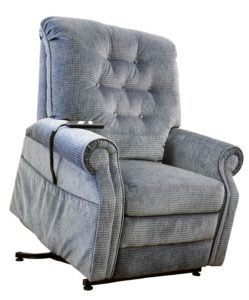 Family caregivers may notice that their elderly family member is having difficulty getting up out of chairs. While you may be able to assist them to stand, it can put strain on your body to do it several times a day. In addition, needing help to get up takes away some of the senior’s independence and trying to stand without help may cause them to fall.
Family caregivers may notice that their elderly family member is having difficulty getting up out of chairs. While you may be able to assist them to stand, it can put strain on your body to do it several times a day. In addition, needing help to get up takes away some of the senior’s independence and trying to stand without help may cause them to fall.
One way you can deal with the problem is to purchase a power lift chair for them. A power lift chair is like a recliner except that it uses a motor to slowly tilt the chair forward to help the senior into a standing position. The same motor also tilts the chair into a reclining position, which can be helpful for seniors who don’t have the strength to do it on their own. It seems like choosing a chair might be just about picking one the caregiver and elderly adult like the looks of. In reality, there’s a lot more to it.
Consider the Different Types
There are three main kinds of power lift chairs: two-position, three-position, and infinite position.
A two-position chair has just one motor. It controls both the back of the chair and the leg rest at once. That means that the back reclines as the leg rest comes up. They typically recline to about 15%, which is usually comfortable for reading and watching television. This kind of chair is ideal for seniors who just need help standing up and who plan to mainly use the chair for watching television.
A three-position chair is one that reclines to a 45-degree angle, which is good for taking naps while remaining in a semi-upright position. These chairs also have one motor that controls both parts of the chair at the same time.
Infinite position chairs have two motors, so the back and leg rest can be moved independently of one another. That means they can be adjusted to any angle the older adult finds comfortable. They can also lie nearly flat for sleeping. Or, the legs can be positioned above the heart to relieve swelling in the legs and ankles.
Get the Right Size
Lift chairs come in different sizes. Choose one that works well for the elderly adult’s height and weight. If possible, bring the older adult to the furniture store and have them try several chairs. Make sure the chair has a few extra inches on either side of the senior so that they will be comfortable. In addition to picking the right size for your older family member, you’ll also need to think about where it will be placed in the house and if there is enough room.
Elderly care providers may need to help the older adult operate the chair at least for the first few times they use it. Also, it’s a good idea to stand by while they are tilting the chair forward to stand up just to make sure they don’t fall. Once the senior feels comfortable using the chair and feels safe, the elderly care aide may be able to take a less active role.
Sources: https://www.spinlife.com/en/HowtoChooseaLiftChair.cfm
